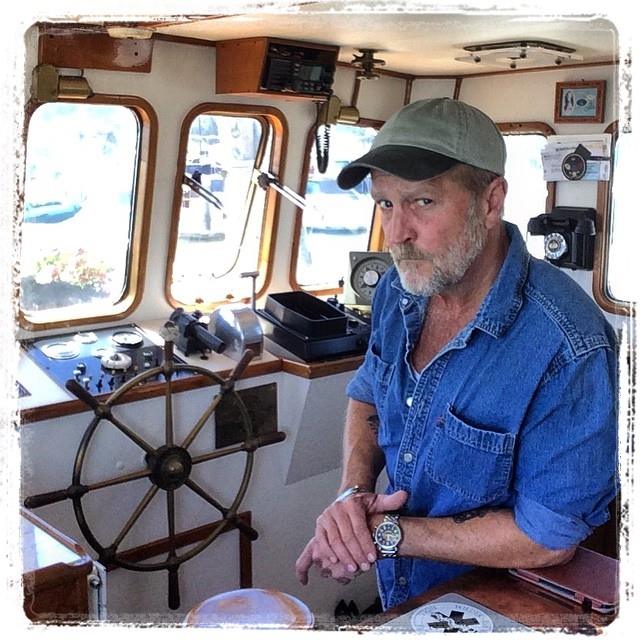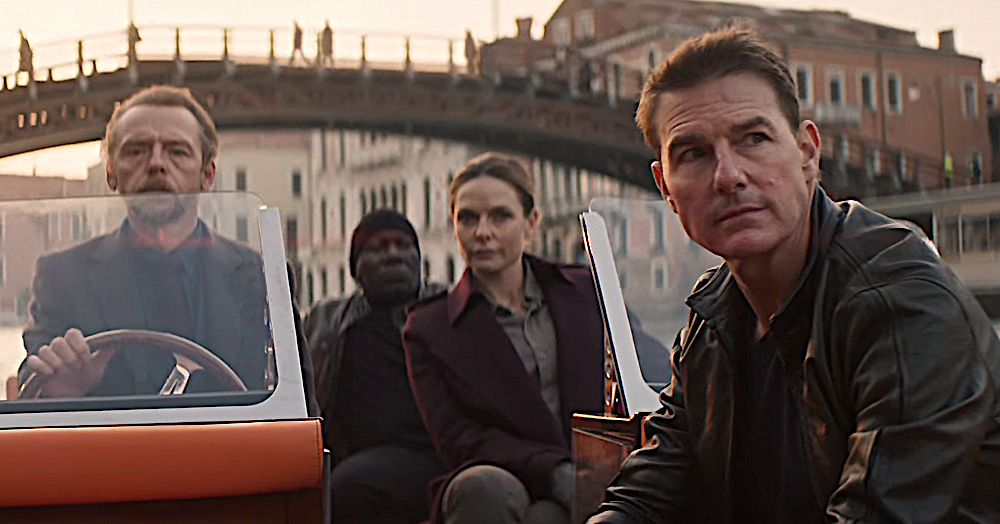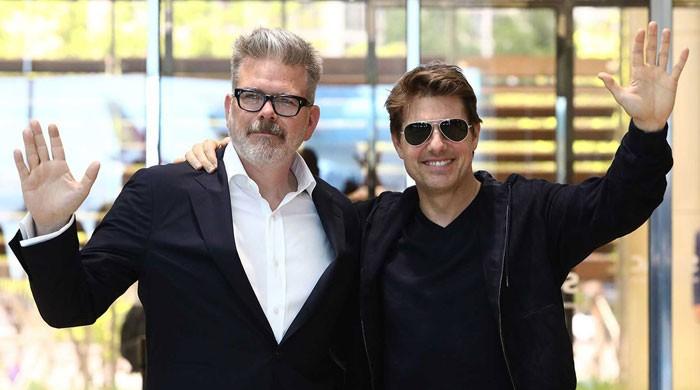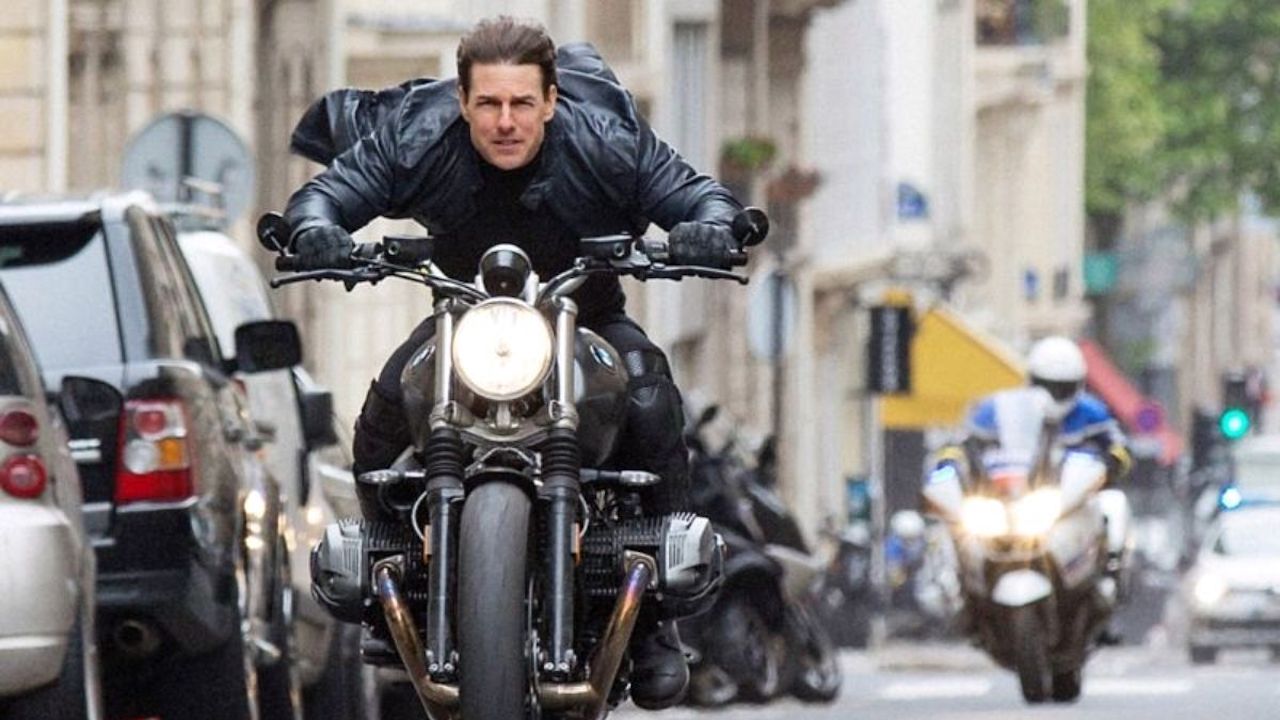- Erik Jendresen Talks Mission Impossible 7 – Dead Reckoning (Part 1)
- Erik Jendresen Talks Mission Impossible 7 – Dead Reckoning (Part 2)
-
Recorded Voice: Good Morning, Ethan. Your mission, should you choose to accept it is … As always, should you or any of your IMF Force be caught or killed, the Secretary will disavow any knowledge of your actions. This disc will self-destruct in ten seconds. Good luck.
Possibly, one of the most recognizable phone messages (or a variant of it) in cinematic history continues to propel Ethan Hunt (Tom Cruise) and his tireless crew Benji Dunn (Simon Pegg), Luther Stickell (Ving Rhames) and Ilsa Faust (Rebecca Ferguson) into death and gravity-defying action to save the world from evil.
Now in its seventh installment, the first Mission Impossible movie was projected onto our screens in 1996 and directed by Brian De Palma. In 2011, Brad Bird took over the reins in Mission Impossible – Ghost Protocol which was co-written by Josh Appelbaum & André Nemec and Christopher McQuarrie. In 2015, McQuarrie assumed both directing and co-writing duties in Rogue Nation, and again in Fallout in 2018. Now, he’s returned with another fully-caffeinated actioner that was so heart-pounding, it had to be split into two parts. Welcome to Mission Impossible – Dead Reckoning (Part One). Erik Jendresen (Band Of Brothers), who co-wrote this adrenaline-fuelled filmic behemoth with Christopher McQuarrie, spoke with Creative Screenwriting Magazine about his writing collaboration and writing process.
To be clear, Jendresen isn’t some hired gun on Dead Reckoning. “Chris McQuarrie and I go way back. We were advisors at the same time at a Sundance Screenwriters Lab in Utah, maybe eighteen years ago,” recalls Jendresen.
Although this is the first official writing credit the two screenwriters share, they developed their writing collaboration over time. “We trust each other implicitly. Chris brings things to the process of storytelling – a very unique point of view, sensitivity, and an awareness of the camera,” fawns Erik. He describes their relationship as complementary.
“We started to become very reliant on one another creatively on whatever project I was working on. I would bounce things off of him and vice versa.” This unofficial collaboration stretches as far back as Fallout, Rogue Nation, and Ghost Protocol. “I was always on the other end of the phone when he needed it, usually to solve story problems.”
After the Pandemic hit, the production schedule for Dead Reckoning was thrown into chaos. Chris McQuarrie and Tom Cruise decided it was time to upgrade Erik Jendresen from consultant to a formal co-writer to complete the scripts for Dead Reckoning Parts 1 and 2. The story construction became a three-headed writing beast.
Each Mission Impossible movie is created in a unique way. “It exercises brand new muscles for a writer. It’s the anti-Sundance. The storytelling is exquisitely collaborative, and very intuitive. It is like you’re making a very high budget independent motion picture. You have the ability and the resources, but also the creative freedom to try things, to pivot, to problem solve in the moment. It is so ridiculously meta to the story,” elaborates Jendresen.
“As a storyteller you really have to be Ethan Hunt, able to make split-second decisions, make the right decisions for the right reasons, and follow your gut. You must always serve character, serve feeling and emotion, and be very aware of the journey and the experience that you’re guiding this audience through.”
Essential Components Of A Mission Impossible Film
The idea behind each sequel is to create a progressively bigger and more terrifying antagonist that would be the “zenith of the experience of the franchise.” In Dead Reckoning, it is “The Entity.” Postures Jendresen, “What is the ultimate threat? What is the ultimate fear? What is the ultimate unknown? What does that villain look like?”
There is always pressure to top each new film “and tell a vital, honest, and relevant story in a way it hasn’t been done,” mainly from Tom Cruise.
“We landed on something that is very relevant to everything that people are experiencing now in a world in which you really can’t tell what’s real and what’s not real, what’s true and what’s fiction. Truth itself is a commodity that’s rapidly disappearing, and that creates a lot of chaos.”

Erik Jendresen
And, in confronting that grave threat, every Mission Impossible film examines the apotheosis of the team looking out for each other. “We’re really invested in the relationships between Ethan, Benji and Luther, Ilsa, and also the principle of what the IMF is all about. I think it’s something that people really embrace,” asserts Jendresen. Ethan Hunt is the core of the team, so his interactions with each of them must also be developed.
The creative process for each Mission Impossible movie begins with Tom Cruise and Chris McQuarrie spitballing ideas for set pieces and reverse engineering the story from those. “We have a find a way for the spectacular sequences to organically fit into the story arc. There’s nothing arbitrary, there’s nothing forced about it.”
Says Jendresen of Cruise, “The man has got the most finely-tuned barometer for story of anybody I’ve ever worked with, because Tom will get fixated on something that he doesn’t understand… and I don’t understand his lack of understanding… until finally I get it.” Erik describes their creative process as “putting each other through a crucible.”
This process extends during production. They might call each other with a scene idea, write it up, and film it the following day. “So, on the fly, we’re changing or improvising something based on the bones that are there. It is filmmaking for all the right reasons in that we’re constantly testing ourselves, questioning ourselves, trying to do better. It’s always a matter of standing on the shoulders of its predecessor.”
Working Off A Story Template
Arguably, a Mission Impossible movie should be relative easy to write. After all, shouldn’t it simply be a matter of inserting a new threat and more elaborate stunts into a set format?
Erik Jendresen paused to ponder. “It’s all stemmed from a principle like the mission statement of the IMF or the motto, ‘We live and die in the shadows for those we hold close and for those we never meet.’”
The screenwriter adds that there are some plot constants in the writing. “There’s a mission. Brief, however it comes… ‘Good evening Mr. Hunt.’ It begins there. And so we’re trying to come up with ways in which Hunt can push himself to a place that we haven’t experienced in cinema and working backwards from there.”
Sure, the locations and action sequences change between movies. “But the true constant with this franchise is emotion. It’s all about moving an audience, not just from one place to another in a story, but moving them emotionally, causing them to really feel, and be that connected to the to the action so that it’s really impactful.”

Benji Dunn (Simon Pegg), Luther Stickell (Ving Rhames), Ilsa Faust (Rebeca Ferguson) & Ethan Hunt (Tom Cruise). Photo courtesy of Paramount Pictures
The writer contrasts Ethan Hunt to James Bond who he describes as a blunt instrument. “Bond’s not a good person. He’s not a good man. He doesn’t really have any principles. Hunt serves his people.”
The team in the Mission Impossible franchise are offered a choice to live as ghosts and only answer to the President Of The United States. Their decisions are irreversible and their lives forever changed. Their backgrounds of being on the wrong side of the law during their pasts, only adds to their intrigue. They’re imperfect people. Their service is both punishment and redemption.
The stakes are always life-threatening for the team as they persist in their dangerous selfless journeys. But, they also make for fascinating character studies. “We discover so much in terms of how the characters feel about each other and what the consequences of their actions have created for them personally and in the world. It’s really an absolute thrill ride, and at times, it’s absolute nonsense, but we always take it very seriously.”
Jendresen – McQuarrie: A Perfect Writing Union
Erik Jendresen won’t over-analyze his writing chemistry with Chris McQuarrie. “I don’t want to be empirical about the process because it is very organic. We laugh a lot. We are two writers who actually love writing and it brings us an awful lot of joy. We really love storytelling and figuring things out.”
Erik embraces Mark Twain’s philosophy that truth is stranger than fiction. “Fiction owes some obligation to reality, but truth doesn’t. The more research that you do, the better you inevitably discover things that nobody could invent.”

Christopher McQuarrie & Tom Cruise
Jendresen confesses to personally having a measured writing process. “My first draft is very compulsive. I usually do two drafts on the screenplay because I take the time in that first draft to make sure I never leave the scene if it’s not working perfectly. I never leave the scene until I know exactly when and where to leave it.” Then Chris gives him some feedback.
“I think both of us are very drawn to stories that are very challenging to make as a film,” muses Jendresen. Both writers enjoy the challenge of solving story problems like a cryptic crossword puzzle. Erik recalls an instance when Chris gave him a note to open one of his stories with an event that didn’t take place much later in his screenplay. “It completely changed the DNA of the story. Just making this one change at the beginning of the opening sequence had a systemic effect on the entire script. It was astonishing. It was actually genius. He will tend to test things by flipping them on their head. What happens if we do this in the opposite way or tell it in a completely different order. Sometimes that leads to tremendous discoveries.”
Says Jendresen of McQuarrie, “He is so finely tuned to clarity and the emotional distinctness of a sequence. He brings that kind of X-ray vision to a draft.”
Oftentimes, when a producer approaches them for their opinion on a potential project, they typically use what’s already on the page and modify the way they look at the story components. Although it happens, they don’t generally start from a place of rewriting. They might change one component that makes the story fall into place. Script Jenga!
